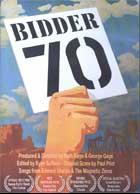
Bidder 70 2013
Distributed by First Run Features, 630 Ninth Avenue, Suite 1213, New York, NY 10036; 212-243-0600
Produced by Beth and George Gage
Directed by Beth and George Gage
DVD, color, 73 min.
General Adult
Environmentalism, Environmental Justice, Environmental History, Criminal Justice, Civil Disobedience, Climate Change, Global Warming
Date Entered: 12/19/2013
Reviewed by Andrew Jenks, California State University, Long BeachIn 1975 Edward Abbey wrote a tale about eco-sabotage called the Monkey Wrench Gang. His work has motivated generations of radical environmental activists, including the subject of this compelling documentary, a college student named Tim DeChristopher. Outraged by the 2008 Bush Administration near give-away of pristine Utah wilderness to energy and mining interests, DeChristopher attempted to undermine the bidding process by securing 22,000 acres of land that he had no intention of developing. DeChristopher’s action was inspired by Abbey’s belief that “sentiment without action is the ruin of the soul” and by the example of Henry David Thoreau. The documentary tells the story of his attempt at “monkey-wrenching,” which ultimately landed him in federal prison for two years. After watching this film, it’s hard to avoid the conclusion that criminal justice came at the expense of simple human and environmental justice, especially given the later invalidation of the entire auction process that DeChristopher had attempted to wreck.
Beyond DeChristopher’s story, which is compelling enough, the film also examines connections between environmental protection and grass-roots democracy. Linking those two things—democracy and environmental protection—Is a hallmark of the environmental justice movement, which has drawn inspiration from both environmental and civil rights activists, who aspire, as Wallace Stegner once said, to create “a society to match our scenery.” The film also illustrates a schizophrenic attitude toward conservation with roots going back to Teddy Roosevelt’s actions to create federal parks. One philosophy was to set aside land from development, in the tradition of John Muir, so that it could be protected from any human intervention other than recreation. A very different view saw wilderness as land that should serve the interests of economic growth. The point where those competing philosophies clash is the bigger subject of this film, and that conflict illustrates a fundamental divide in the United States over how best to manage natural resources – and to what purpose those resources should be put. The Bureau of Land Management – whose current employees would not be interviewed for the documentary – was at the forefront of the clash between these two philosophies. In the end, the Obama administration removed many of the parcels up for bid from development, thus making DeChristopher’s quest less quixotic than many had believed at the outset. Yet those actions did not stop the DeChristopher’s prosecution during the Obama presidency, illustrating that the divide between those who want to preserve and those who want to develop federal wilderness does not match up neatly with political parties. And when DeChristopher returned to his childhood home state of West Virginia he witnessed the devastating impact of ongoing mountain-top removal mining, which has enriched coal companies immensely but left locals as poor as ever before.
This is advocacy documentary film-making. Supporters of more economic development of federal land, or global warming sceptics, are almost completely excluded from the film, except as objects of scorn. Some may find that approach off-putting, while others—those seeking a rallying point and personality to spearhead a renewed focus on environmental justice and political transparency—will embrace it and cheer loudly. Regardless, the film raises critical issues in a way sure to encourage lively discussion and debate in the classroom.